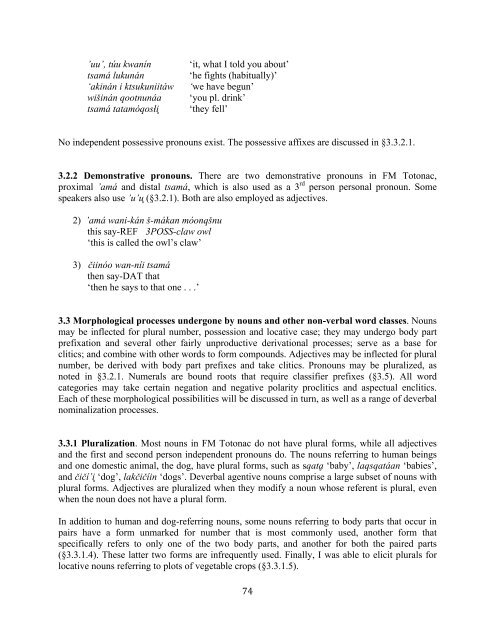The phonology and morphology of Filomeno Mata Totonac
The phonology and morphology of Filomeno Mata Totonac
The phonology and morphology of Filomeno Mata Totonac
You also want an ePaper? Increase the reach of your titles
YUMPU automatically turns print PDFs into web optimized ePapers that Google loves.
’uu’, túu kwanín ‘it, what I told you about’<br />
tsamá lukunán ‘he fights (habitually)’<br />
‘akinán i ktsukuniitáw ‘we have begun’<br />
wi#inán qootnunáa ‘you pl. drink’<br />
tsamá tatamóqos*i" ‘they fell’<br />
No independent possessive pronouns exist. <strong>The</strong> possessive affixes are discussed in §3.3.2.1.<br />
3.2.2 Demonstrative pronouns. <strong>The</strong>re are two demonstrative pronouns in FM <strong>Totonac</strong>,<br />
proximal ’amá <strong>and</strong> distal tsamá, which is also used as a 3 rd person personal pronoun. Some<br />
speakers also use ’u’u" (§3.2.1). Both are also employed as adjectives.<br />
2) ’amá wani-kán #-mákan móonq#nu<br />
this say-REF 3POSS-claw owl<br />
‘this is called the owl’s claw’<br />
3) $iinóo wan-níi tsamá<br />
then say-DAT that<br />
‘then he says to that one . . .’<br />
3.3 Morphological processes undergone by nouns <strong>and</strong> other non-verbal word classes. Nouns<br />
may be inflected for plural number, possession <strong>and</strong> locative case; they may undergo body part<br />
prefixation <strong>and</strong> several other fairly unproductive derivational processes; serve as a base for<br />
clitics; <strong>and</strong> combine with other words to form compounds. Adjectives may be inflected for plural<br />
number, be derived with body part prefixes <strong>and</strong> take clitics. Pronouns may be pluralized, as<br />
noted in §3.2.1. Numerals are bound roots that require classifier prefixes (§3.5). All word<br />
categories may take certain negation <strong>and</strong> negative polarity proclitics <strong>and</strong> aspectual enclitics.<br />
Each <strong>of</strong> these morphological possibilities will be discussed in turn, as well as a range <strong>of</strong> deverbal<br />
nominalization processes.<br />
3.3.1 Pluralization. Most nouns in FM <strong>Totonac</strong> do not have plural forms, while all adjectives<br />
<strong>and</strong> the first <strong>and</strong> second person independent pronouns do. <strong>The</strong> nouns referring to human beings<br />
<strong>and</strong> one domestic animal, the dog, have plural forms, such as sqat! ‘baby’, laqsqatáan ‘babies’,<br />
<strong>and</strong> $i$í’i" ‘dog’, lak$i$íin ‘dogs’. Deverbal agentive nouns comprise a large subset <strong>of</strong> nouns with<br />
plural forms. Adjectives are pluralized when they modify a noun whose referent is plural, even<br />
when the noun does not have a plural form.<br />
In addition to human <strong>and</strong> dog-referring nouns, some nouns referring to body parts that occur in<br />
pairs have a form unmarked for number that is most commonly used, another form that<br />
specifically refers to only one <strong>of</strong> the two body parts, <strong>and</strong> another for both the paired parts<br />
(§3.3.1.4). <strong>The</strong>se latter two forms are infrequently used. Finally, I was able to elicit plurals for<br />
locative nouns referring to plots <strong>of</strong> vegetable crops (§3.3.1.5).<br />
! +(!

















